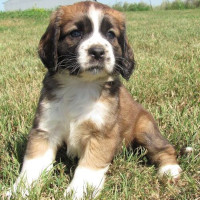Appearance of the Mini St. Bernard
|
| Mini St. Bernards come in two sizes. The Micro measures 30.5 to 40.5 centimeters and weighs around 7 to 16 kilos, and the Nehi measures 40.5 to 51 centimeters and weighs around 18 to 27 kilos. They have large brown eyes, a broad black nose, floppy ears and a short muzzle. Mini St. Bernards have the build of St. Bernards but without the extra bulk, and have either straight, silky coats or wavy, rough coats. They are generally of medium length and can come in a variety of colors, including black, brown, red, cream, fawn, white, brindle, silver, blue or a combination of these. |
Temperament of the Mini St. Bernard
|
| The Mini St. Bernard is a friendly, social breed that likes to be with its family, the bigger the better. They are good with children of all ages and animals of all kinds. However, they don't like strangers, so they make good watchdogs. They're intelligent dogs who learn quickly and train easily for the most part, although you have to be firm to prevent them from becoming stubborn. Early socialization is important, as they can become anxious if not used to being around other animals. In addition, Mini St. Bernards don't like to be alone for long periods and can suffer from separation anxiety. |
Needs and activities of the Mini St. Bernard
|
| The Mini St. Bernard is more active than the traditional St. Bernard Dog and needs at least 45 minutes to an hour of vigorous exercise every day to stay healthy. They can become overweight without the right amount of activity. What's more, Mini St. Bernards can become anxious or bored if they don't get enough exercise. Some interesting activities for your dog include playing off-leash at the dog park, going for long walks, hiking in the woods or simply playing fetch or catch in the backyard. They're neither fast nor super-athletic, but they can benefit from agility or flyball training. |
Maintenance of the Mini St. Bernard
|
| The amount of maintenance your dog needs depends on whether your Mini St. Bernard has a fine, silky coat or a rough, dense coat. Most likely, your dog will need daily brushing with a pin brush and comb to avoid tangles and mats. They shed a little, but it's not excessive like some furry dogs. They don't need to be bathed often, and when you do, you should use a mild dog shampoo to avoid dry skin and irritation. Clean your dog's ears weekly and trim his nails if necessary. You may also need to wipe under their eyes from time to time, as they produce a lot of moisture. |









 English (United Kingdom)
English (United Kingdom)